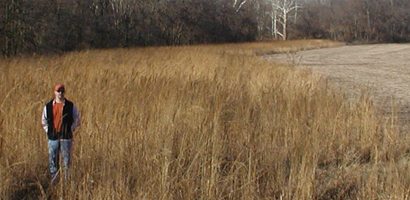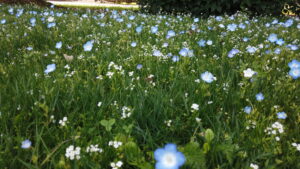Fasten your seat belt and keep your wits about you—the native seed industry is one wild ride.
“There’s nothing ‘nichier’ or riskier than the native seed industry,” says one industry professional who thrills at the twists and turns of his trade. “The sheer scope of what can and cannot happen, be it weather- or fire-related, can make it a pretty big gamble. We can go from huge consumption years—the combination of a Conservation Reserve Program sign up with a fire year—and millions of pounds of seed down to very few pounds … It’s very hard to predict,” says Mark Mustoe, co-owner and manager of Clearwater Seeds of Spokane, Wash.
As much as Mustoe—and many other professionals in the industry—would like to peer into a crystal ball for answers to the tricky question of supply and demand, Mustoe and his ilk know how to ride the ups and downs of the industry, even the unprecedented loop-the-loops of the past two years.
The economic recession has directly impacted Mustoe’s as well as other seed businesses in the native seed industry—seed companies that provide native grasses, wildflowers, forbs and legumes for habitat restoration, rehabilitation and reclamation projects on land disturbed by natural occurrences or human industry and development.
According to Mustoe, the native seed industry is holding its own despite the recession. “The industry as a whole has been pretty resilient,” he says. But adds the downside is that companies are building inventory and the industry is in a downward price spiral. Also, the recession has made access to credit more difficult for the small- to medium-sized businesses that make up the industry, thereby affecting how the industry conducts its business on a daily basis. “These restrictions hamper new business and the ability to go out and hire new people,” says Mustoe.
Now he says he is looking at his bottom line and ways in which his company can do things more efficiently and effectively. “We’re all getting leaner and trying to have a business model that works and that business model is changing right now in the seed industry … period. I don’t know that the industry has ever been in such a state of flux on so many levels. We’ve always had cyclical ups and downs … but we’ve thrown this economy and banking issues into the mix—that’s a lot.”
To survive the rapidly changing environment, Mustoe and his company are evolving: “We are learning to grow different species and we are becoming more adaptable. All of us who are doing this like it and its challenges … To be in this industry you have to be forward-thinking, a bit of a risk taker and someone who thinks outside the box,” he says.
Mustoe suggests watching trends closely, like what materials are in demand from the Department of Transportation, Fish and Wildlife Service, the Natural Resources Conservation Service through the Plant Materials Centers or conservation programs such as the Conservation Reserve Program. But, he admits, watching trends has its limitations. “We see trends … but even changing personnel in places of significance can play a role in what plant material is being selected and what isn’t,” he says. He also suggests diversifying the types of species being grown to absorb turmoil caused by the economy and cyclical downturns.
According to Mustoe, demand from government agencies for native seed is decreasing in all areas, so companies that sell native seed will need to employ many different strategies to bolster sales revenue. “The Bureau of Land Management, the largest land owner in the Western United States, does not have a budget line item for restoration seed purchase. BLM staff is granted emergency funding for fire rehabilitation and they do use that money for seed purchases, but even those funds are limited. Some agencies are not doing much fire rehabilitation … even on critical erosion areas,” he says.
Bill Agnew, president of Granite Seed Company of Lehi, Utah, is also concerned about the impact the recession is having on funding from federal agencies. “The economy is impacting the seed industry and it’s impacting every segment of the work base we have. Federal agencies are cutting back. As a consequence, federal projects on reclamation for enhancement may be reduced, and that impacts the sale of seed. All those projects call for seed; for example, mining operations typically are reduced when the economy is flat,” says Agnew.
Like Mustoe, Agnew says working in native seed is a roller-coaster ride he enjoys, and he has a few strategies of his own to cope with the unpredictability of supply and demand. “The trick is to figure out the balance in between and flatten out the curves,” he says.
Agnew has diversified his company’s customer base, not only doing business with federal agencies but with state, county and local government; universities; real estate developers; ski companies; golf courses; homeowners; the farming and ranch community; coal, utility, oil and gas, and metal companies and so on. “That’s our strength—the strength in being able to diversify over time and having relationships with a lot of different customer types,” says Agnew. Another way he’s diversified is providing consulting services. But, most importantly, Agnew stresses the importance of the golden rule of business—providing excellent service, especially in times of economic turmoil. “Availability is everything, but so is reputation and service,” he says.
Long-term commitment also helps temper the unpredictable nature of the industry and the tricky balance of supply and demand. “You’re not in and out of this business. You’re in it for the long haul,” says Tom Lutgen, president of Star Seed Inc., located in Osborne, Kan. His company has been selling native seed for 75 years. “There are some years you harvest more seed than you’re going to need and some years you don’t. We realize we have these ups and downs in the supply and demand system,” he says.
Lutgen is anticipating another upswing in the market. Last August, farmers took part in the first general CRP sign up since 2006. The CRP is a voluntary program through which landowners receive annual rental payments and cost-share assistance in return for establishing long-term, resource-conserving covers for eligible lands. Lutgen says new seeded acres could provide a boost to the industry, but, he notes, the benefits may not be felt for some time.
Understanding demand is harder now than when the CRP was established in 1985. Back then, Lutgen recalls, most of the CRP land was planted with warm season native grasses, with little, if any, wildflower or forb species, thus making demand easier to figure out. “It has evolved over the last 10 years … Major changes have been made with the introduction of components to benefit and attract wildlife and pollinating insects,” says Lutgen.
“Right now it’s a new program and it’s changed since the last time there was a general CRP sign up. I don’t think the field officers really know what the final seed mixtures are going to be,” says Lutgen. “Right now, from the phone calls and information we’re getting, the industry is gearing up.”
According to Lutgen, one of the challenges the industry could face is determining seed needs. “It is unknown if re-enrolled acres will have to have additional seeds, if so, what kinds and how much? There are different reports from states and from within states. At some point in time we’ll be able to get more of a read on what that is, but at this point in time it’s pretty hard to analyze the information and come up with an accurate forecast for each specific cultivar of grasses, forbs and wildflowers that will be needed,” he says.
Another issue is long-term use versus immediate requirements of CRP land. Farmers who may be interested in providing habitat for wildlife at the beginning of their CRP contracts may want to conv
ert it to grazing land by the end of the term. “What’s good for wildlife may not be the best thing to have long term for a cattle rancher. That is where some of the concern is coming from right now for some growers,” says Lutgen. He suggests cooperation and balance may be the way forward to a happy resolution for all partners.
Now, many industry professionals would welcome that crystal ball to predict supply and demand, which may keep industry professionals guessing well into the new year, especially after changes to the 2008 Farm Bill provided bonus eligibility points in the environmental benefits index to growers who included pollinator plantings in their bids for CRP contracts.
The new pollinator provisions included in the bill could mean more than just a short-term boost to wildflower and forb sales. According to Tom Van Arsdall, public affairs director for the Pollinator Partnership and the North American Pollinator Protection Campaign, it represents a significant collaborative opportunity for members of the native seed industry.
“The seed industry has an opportunity and a potential market as we look at changing what we put on highway rights of way, as farmers look at what they put in their wildlife habitat or intercropping and as seed growers look at what source of crop they use to grow seeds for the seed industry. Through collaborations we can take what may have been sporadic markets, some that might not be economic and build a mosaic of markets for native seeds. You start getting a larger-scale market, and one that helps result in landscapes, from our perspective, that are more welcome and sustainable for pollinating insects,” says Van Arsdall.
The importance of pollinating insects is undisputed as one out of every three bites of food we consume is brought to us in partnership with pollinating insects as well as the reproduction of at least 80 percent of flowering plants. Honey bees pollinate an estimated $15 billion worth of crops in the United States each year, with native bees providing pollinating services to crops worth another $3 billion or more. Equally important at this time, is the involvement of the seed industry to be a voice advocating the necessity of funding conservation programs like the CRP.
“One of the things the seed industry can do is fight for conservation dollars so that these programs are adequately funded. That way, farmers get the technical assistance and financial incentives they need to transform their practices and impact on the landscape,” says Van Arsdall.
“From the perspective of the seed company, it’s a business decision—this matters to the bottom line. As farmers, particularly if you’re in the native seed business, decide to integrate and put in planting mixes for the CRP—that is a market opportunity. A lot of individual companies can take ownership in their own marketing or public awareness efforts to say pollinators are important, plant for pollinators,” he says.
Working in the native seed industry may take its seed professionals on the ride of a lifetime—but they wouldn’t have it any other way. “We’re in this business to make money. We enjoy being a profitable business … but there’s something about putting this land back to the way it was—there’s something special about selling native seed,” says Lutgen.
Kari Belanger













